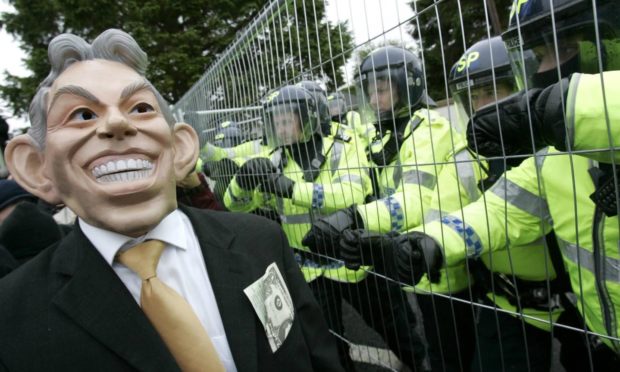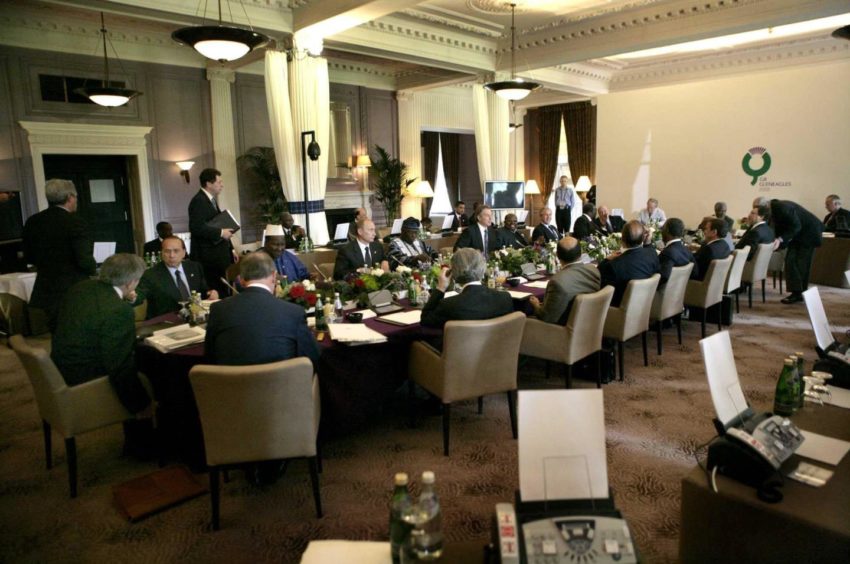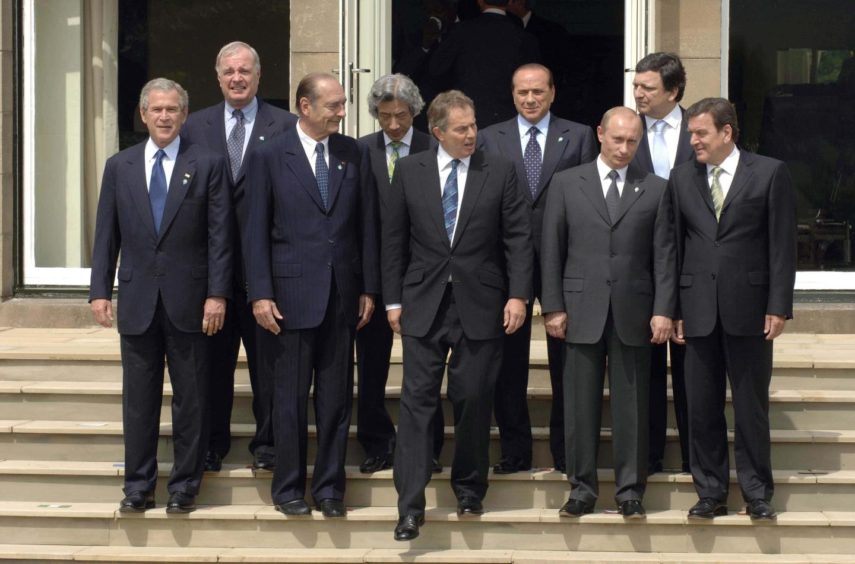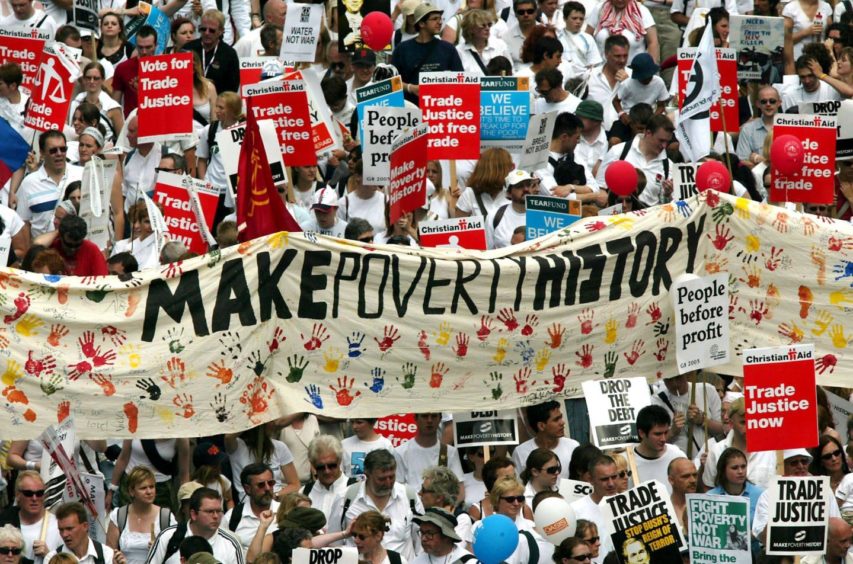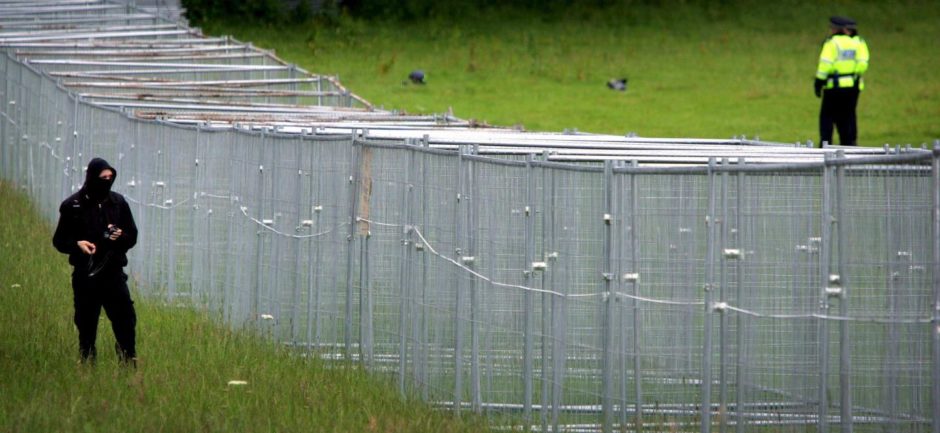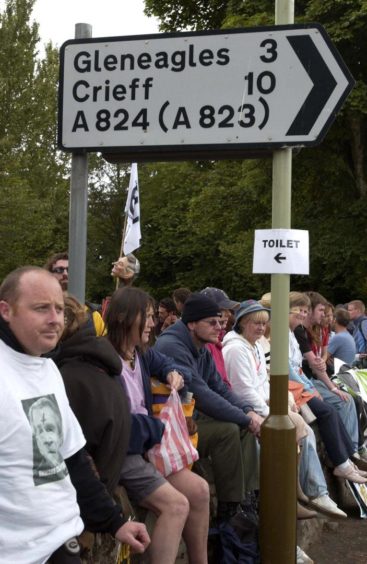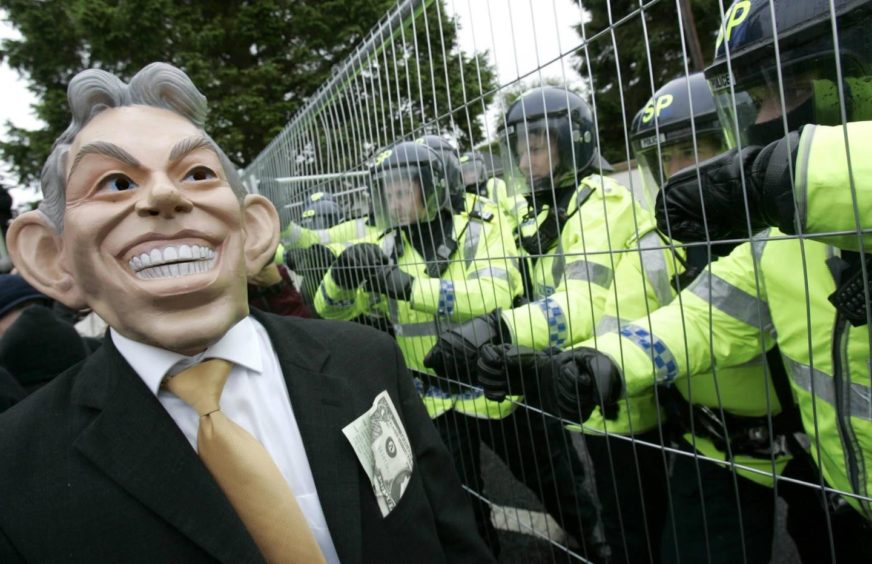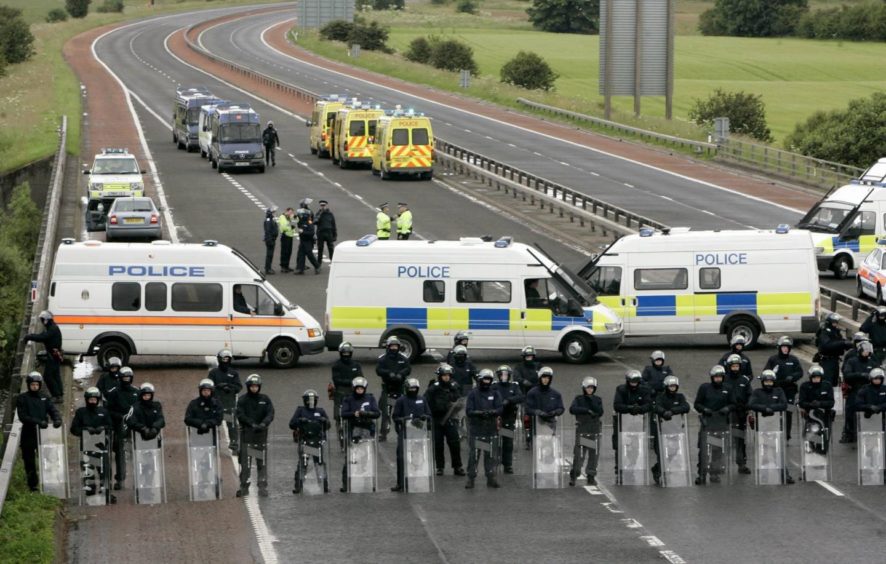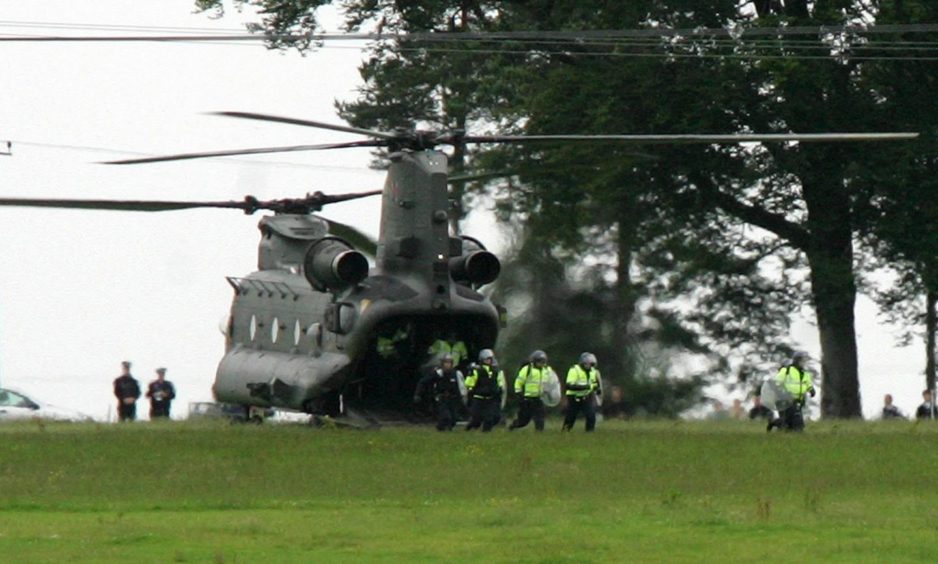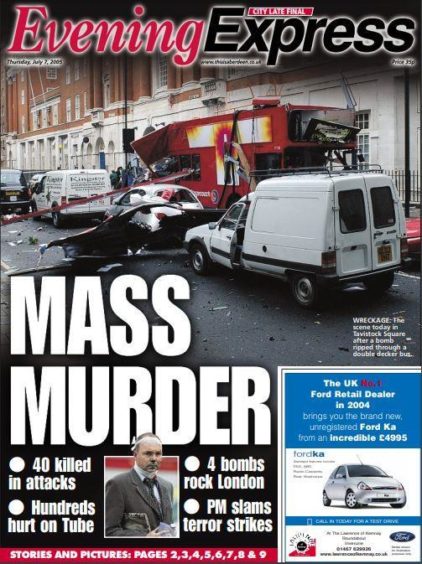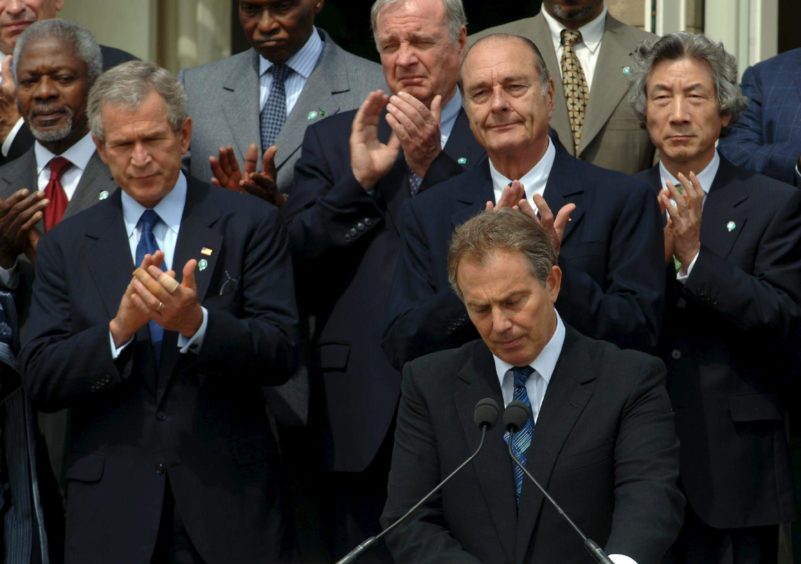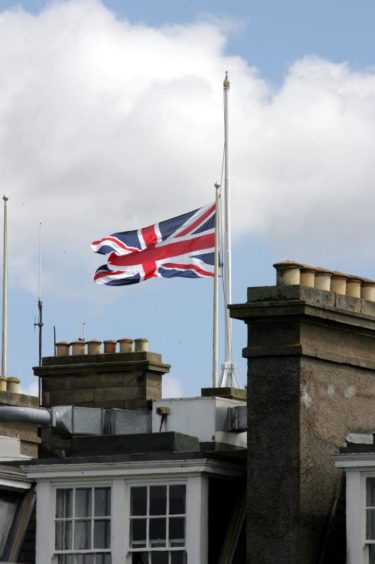The small town of Auchterarder was thrust into the global spotlight in 2005 when the G8 Summit brought the political leaders of eight nations together at Gleneagles Hotel.
All eyes were on Perthshire when representatives of seven countries arrived on July 6 for three days of inter-governmental discussions, hosted by the UK and its Prime Minister Tony Blair.
As well as historic moves to eradicate poverty, the conference is remembered for an expensive, huge-scale policing operation, riots, terror fears – and former US President George W Bush falling off his bike.
But it was not the first time that Gleneagles had been the location for tense talks.
The luxury hotel was “shrouded in a veil of secrecy” in 1986 when the venue hosted a highly-classified Bilderberg meeting.
The conference discussed issues including South African apartheid and the Soviet Union, amid a looming, collective fear of Libyan terrorism.
Nearly two decades later in 2005, the agenda was not hugely different for the 31st G8 summit – the first to be held in Scotland – with poverty, global warming and counter-terrorism up for discussion.
Sadly, the summit was rocked by terrorism, not in Scotland, but the devastating attacks in London on July 7.
Poverty, protests and policing
The G8 Summit was to take place against a backdrop of political protest which had been gaining momentum in 2005.
The unprecedented Make Poverty History campaign saw charities, religious groups, celebrities and the public unite to put pressure on the government to end absolute poverty.
Just days before the summit was due to start on July 6, more than 200,000 anti-poverty campaigners came from all over the world to take part in a huge march in Edinburgh, and form a human chain.
Tayside Police were concerned – were hundreds of thousands of people going to descend on Auchterarder too?
Planning for policing the event began 18 months beforehand, and by the time the summit came round, almost 11,000 officers were ready for duty.
Police leave was suspended for the two weeks surrounding the meeting, and officers had been drawn from other constabularies across Scotland and the UK.
A 52-mile fence was erected around Gleneagles and its grounds, quite simply, it was the biggest policing operation seen in the UK.
More than 2,500 police vehicles were waiting in the wings, 200 police dogs were ready to assist and 60 horses were on standby if things really got out of hand.
There was tactical support from helicopters and – with fears of protesters arriving by sea – there was even a water-borne force deployed from Strathclyde.
Such were the concerns over a bombing at the event, that customers at the BP petrol station on North Esplanade West in Aberdeen were baffled when they were refused petrol for their jerry cans.
Petrol stations around Edinburgh had restricted the use of jerrycans in the days around the G8 summit, but the Aberdeen blunder was an oversight amid heightened tensions.
Two days before the biggest event ever seen in Auchterarder, the scale of the operation really hit home.
Fearing violent protests, shopfronts were boarded up.
Patrol cars monitored every entrance to the town from the A9, foot patrols were stepped up, vans took up residence on the High Street and officers on horseback patrolled the road to Gleneagles.
A barricade had been set up en route to the hotel and no person or vehicle was allowed through without inspection.
But the day before the conference, the town centre was brought to a standstill when police were warned of a bomb plot.
Business owners evacuated their premises and pedestrians were asked to leave, the High Street was cordoned off and sniffer dogs descended on the Royal Bank of Scotland.
A Tayside Police spokesman later confirmed it was a hoax, but the bank was not taking any chances and decided to close for the rest of the week.
But despite the disruption and diversions, many locals were positive.
One resident said: “Hopefully something historic will happen, and Gleneagles and Auchterarder will be remembered forever for making poverty history.”
Violent clashes
The much-anticipated day of the summit brought “violent and chaotic” scenes.
Dozens of arrests had been made in Stirling first thing when police and shops were attacked.
Sit-down motorway protests brought widespread disruption to Perthshire and smaller groups peeled off to blockade rural roads.
With tempers fraying, police tried to cancel a planned march through Auchterarder that afternoon.
Buses of protesters were held at Perth, under surveillance and awaiting police authorisation to proceed.
Although delayed, there were later cries of joy from campaigners when a crowd of 5,000 made it to Auchterarder and set off to Gleneagles, banners aloft and chanting.
But parts of the protest turned violent.
Hundreds of people breached police lines and protesters clad in black wearing helmets pulled down a section of the fencing.
A Chinook helicopter landed nearby to deploy police in riot gear and more reinforcements were brought down from Grampian Police.
A hardcore criminal group was condemned by Tayside Police for darkening an otherwise peaceful protest, which resulted in dozens of arrests and saw police officers injured.
Then Fife Police chief constable Peter Wilson vowed to deal “swiftly” and “robustly” with further trouble and said the scenes were an “abomination”.
There had already been drama earlier in the day when President George W Bush collided with a policeman and fell off his bike when waving at officers.
He suffered cuts and scrapes to his hands and arms, and the police officer was taken to hospital with a leg injury.
But later that afternoon, just a few hundred metres away, the leaders of the world’s wealthiest nations were locked in heated negotiations.
Climate change was top of the agenda on day one, but day two was memorable for all the wrong reasons.
Terror fears realised
On the morning of July 7, the protests were more peaceful and there was a sense of calm at Gleneagles.
But 400 miles away, the usual bustle of morning rush hour in London was disrupted.
Three bombs were detonated in quick succession on the London Underground and a fourth on a bus.
Just hours beforehand there had been jubilant scenes in the capital as London was announced as the host for the 2012 Olympics.
But the elation was shattered, the tragic events claimed the lives of 52 people and injured 700 more.
The G8 organisers’ terror fears had been realised.
Terrorists had not targeted the conference itself, but knowing a huge number of Metropolitan Police and their resources were in Scotland saw an opportunity.
Tony Blair temporarily left the summit to return to London to chair a Cobra meeting before flying back into Dundee Airport the same night under military escort.
A previously unseen document released by National Records of Scotland earlier this year revealed the Scottish Government’s worries about policing and terrorism ahead of the meeting.
One report detailed the £72 million cost of policing the event and First Minster Jack McConnell’s concerns that the cost put the Scottish Executive in an “intolerable position”.
In a grim prediction, another report said: “London is a more likely target than anywhere in Scotland, but the G8 summit will certainly bring Scotland into the middle of the frame temporarily and the east coast oil installations remain a constant concern.”
Like the rest of the UK, a sombre mood descended on the leaders’ meeting, the flag at Gleneagles was flown at half-mast.
The final day of the G8 Summit saw policing scaled down, the death toll in London was rising and overshadowed the protest.
Subdued, there were no attempts to breach the security fence or the police line.
The summit ended with a historic agreement to give a £28 billion boost to developing countries, as well as cancelling the debt of Africa’s 18 poorest nations.
Tony Blair praised the people and police of Perthshire for their “calm attitude” amid considerable disruption during their time on the world stage.
All eyes will be on the UK once again on June 11 when the small seaside resort of Corbis Bay in Cornwall hosts the G7 Summit 2021.
Some protests are already under way, but nothing on the scale of the unprecedented and unforgettable scenes in Auchterarder in 2005.
